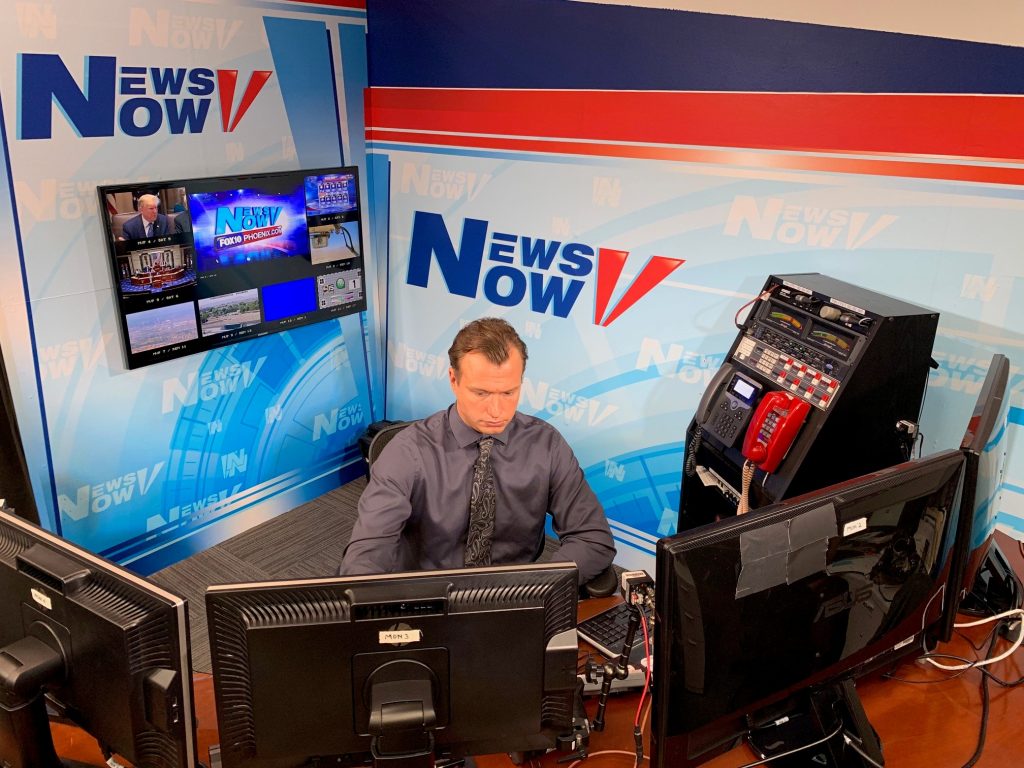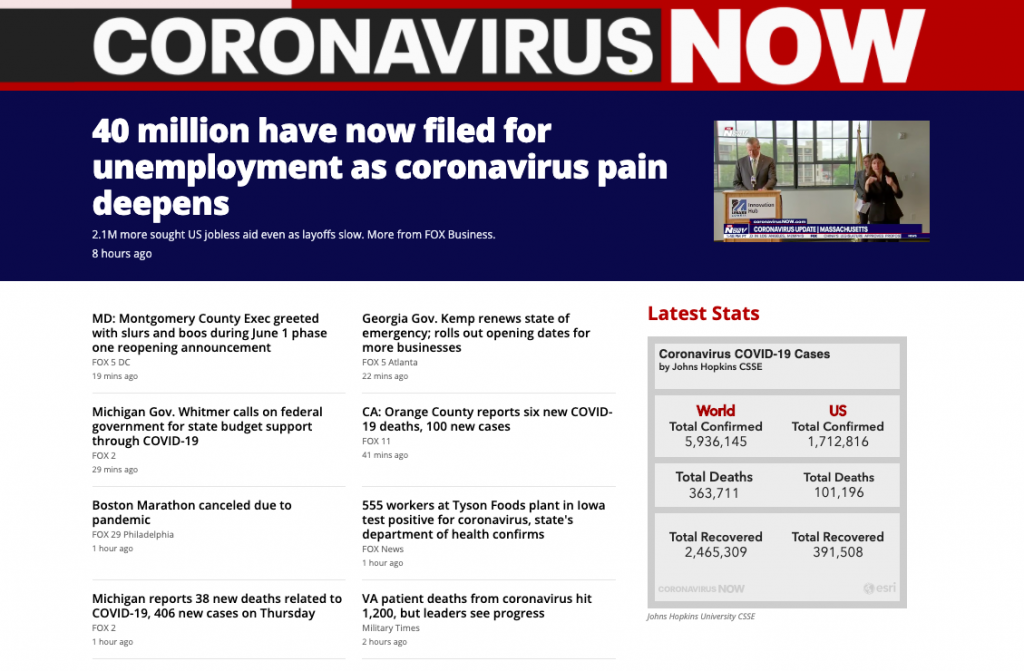Every weekday morning at 6 a.m., Mike Pache reports for work at Fox 10 Phoenix (KSAZ), where he has just one hour to prepare for five hours of live anchoring…and producing….and directing…and switching…and creating graphics…and editing clips for YouTube along the way. Pache is one of three newscasters responsible for 14 hours a day — 7 a.m. to 9 p.m. Pacific Time — of live coverage (as well as programming a taped overnight playlist) on a streaming channel called Fox News Now (not to be confused with the Fox News cable channel).
Fox calls the three anchors “DJ’s,” short for digital journalists, but in a way they are deejays too: no scripts, no teleprompter, no program grid — they just wing it on the fly.
“You do it so much, you sometimes fail to realize that you just put on a show all by yourself,” says Pache. “I don’t think I could sit up there and do it,” says Pache’s boss, KSAZ news director Doug Bannard, who oversees the News Now project. “Rubbing my head and patting my tummy is enough.”

The News Now streaming channel has been available for the past 5 ½ years on YouTube, where it just passed the 1M sub mark, and on Fox owned-station websites, hopscotching among live events such as news conferences and car chases around the country. But now, like so many news sources, it has found a new purpose: covering COVID-19 as part of an ambitious group-wide initiative by the Fox stations called CoronavirusNow.
The CoronavirusNow website went live on March 10 — props to the marketing and legal teams, by the way, for securing that URL. It was a quick launch triggered by a brainstorming session among senior Fox Stations executives late in February. “In the early days, there was a lot of fragmented reporting and information and news coverage,” says Fox TV Stations digital chief Steve Chung. “And it was very difficult to kind of pull it all together.” “Clearly there was a need for information,” says Bannard. “We wanted to have a one-stop shopping destination for people to find it.”

CoronavirusNow is Fox’s answer: an online aggregation site that combines content from 18 owned stations and other company assets (such as Fox Business). But unusually, there are also multiple links to stories from other sources — not just agencies like the AP or Reuters but organizations like NPR and the BBC. “It was really about how we get the best information to the users in the best way possible, and bring the best of what we have and be humble about the stories that we may not have but the users will find valuable,” says Chung. “It’s not our M.O. in normal times, but in special situations like this, when life is at risk and public safety is of foremost importance, we thought this is the right thing to do. And we did it.”

But what about video? These are television stations, after all. About a week in, the Bay Area’s KTVU began producing a two-hour morning block for the new service, but Fox soon realized that a simpler solution was hiding in plain sight — the up-and-running News Now channel out of Phoenix. So Fox Stations COO Sharri Berg called Doug Bannard and told him what he’d won: a key role in what she called a “pop-up news channel.”
So now, when Mike Pache and his colleagues Pilar Arias and Kristi Larson sit at their Tricasters in the KSAZ newsroom all day and into the evening, they’re churning out a mix of pandemic-related briefings and a steady supply of tape segments from the Fox stations, many produced specifically for the new channel. “It’s been an embarrassment of riches when it comes to content,” says Bannard — not just an abundance of live events, but long-form interviews from anchors stuck at home with time on their hands and a new national platform for their work. “I feel like it makes everything just open up as far as transparency,” says Pache. “We’re not just showing you just one soundbite or two soundbites. I feel like the viewers are seeing the whole story right in front of them.”
Watch a segment on CoronovirusNow.com from Fox’s Detroit station WJBK
The DJ’s post shorter clips from the day’s coverage on YouTube to generate some additional revenue, but Steve Chung says CoronavirusNow was created as a public service, not a commercial opportunity — “I know that may sound [like a] cliché to the casual observer, but that’s fact.” That said, I pressed him for some lessons that may serve the Fox stations well down the road. Here are three that struck me:
●Fast innovation
Like a lot of station executives nowadays, Chung was amazed at how quickly disparate but determined teams can build something new. “This one was supercharged, from content to technology to legal to marketing. It was magical to see this orchestra come to life in a matter of days.”
●Improvisation and adaptability
The venture kept evolving even after launch — the pivot in video partners is just one example — and Chung has no intention to stop adapting as circumstances change. “You can see the evolution: we didn’t sit there with a McKinsey consulting deck and say this is the master plan of what the CoronavirusNow effort is going to look like. Because the world was very uncertain, and it’s still uncertain what the future may hold.”
●Local/national collaboration
CoronavirusNow, like other station group initiatives pegged to the pandemic that we’ve written about from Gray, Hearst, Scripps, ABC and Telemundo, illustrates the “unique power of a local station group being local, but having a national asset base,” says Chung. “We’ve learned [that] when our local station group converges to put a national product together, the content is extremely compelling.”
Watch a clip uploaded to CoronavirusNow.com from Fox’s Bay Area station KTVU
CoronavirusNow is also available on the Fox Now network app as well as Samsung TV Plus, a streaming service bundled with the company’s smart sets. Coincidentally, Chung and his fellow executives were already discussing how to take the Phoenix-based live stream and turn it into “a more full-fledged OTT experience” when the pandemic struck. “All of these lessons are going to feed into our broader OTT strategy,” Chung says. “And we’ve learned a ton from this experience, so the book is still being written as we speak.”
But meanwhile, back in the KSAZ newsroom, “this is a time of remarkable public service,” says Doug Bannard, “and whatever we can do to reach people on any platform we should do: it’s a win. I think we would all agree that if you want to be relevant, now’s the time to be relevant.”
